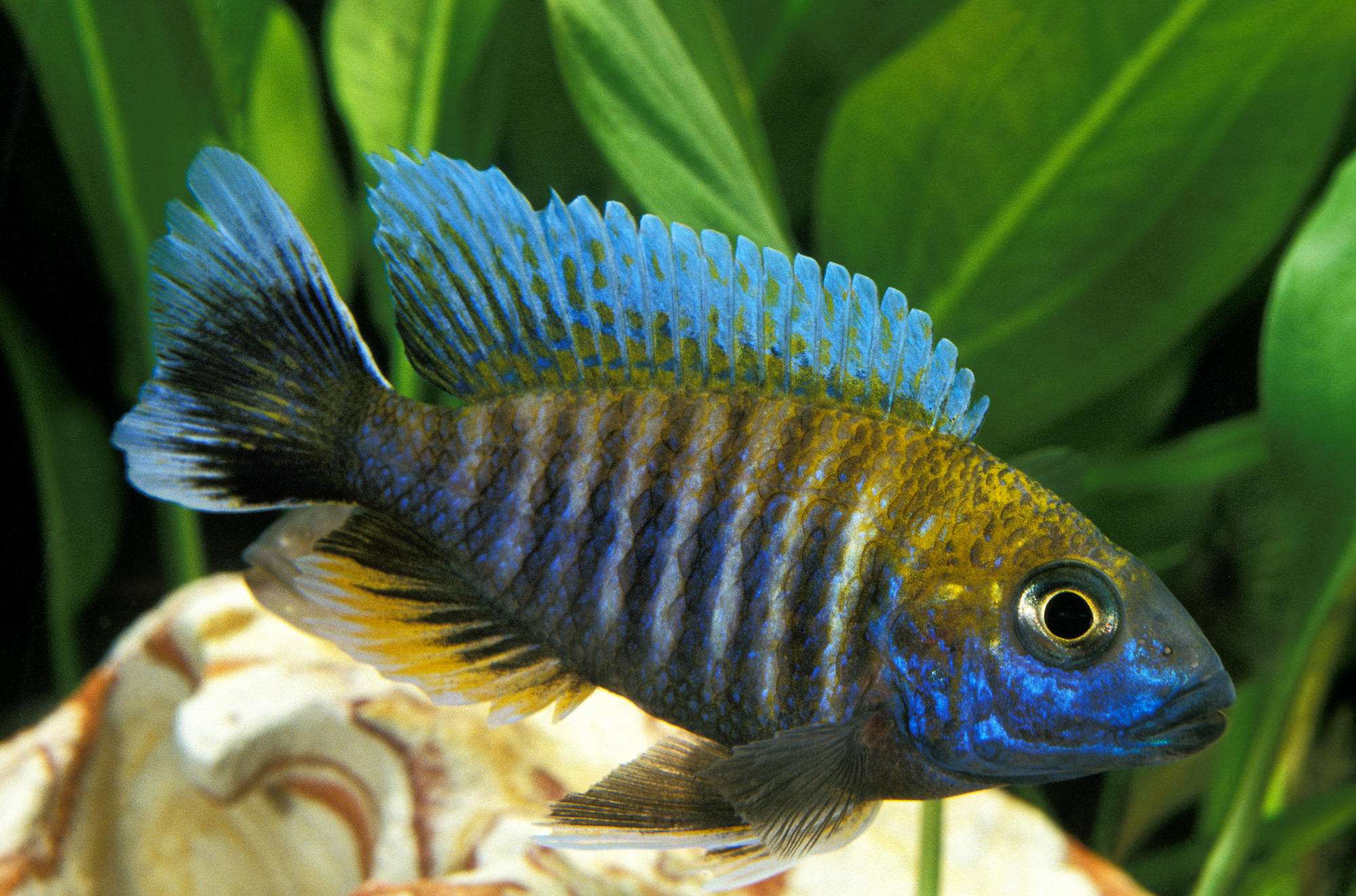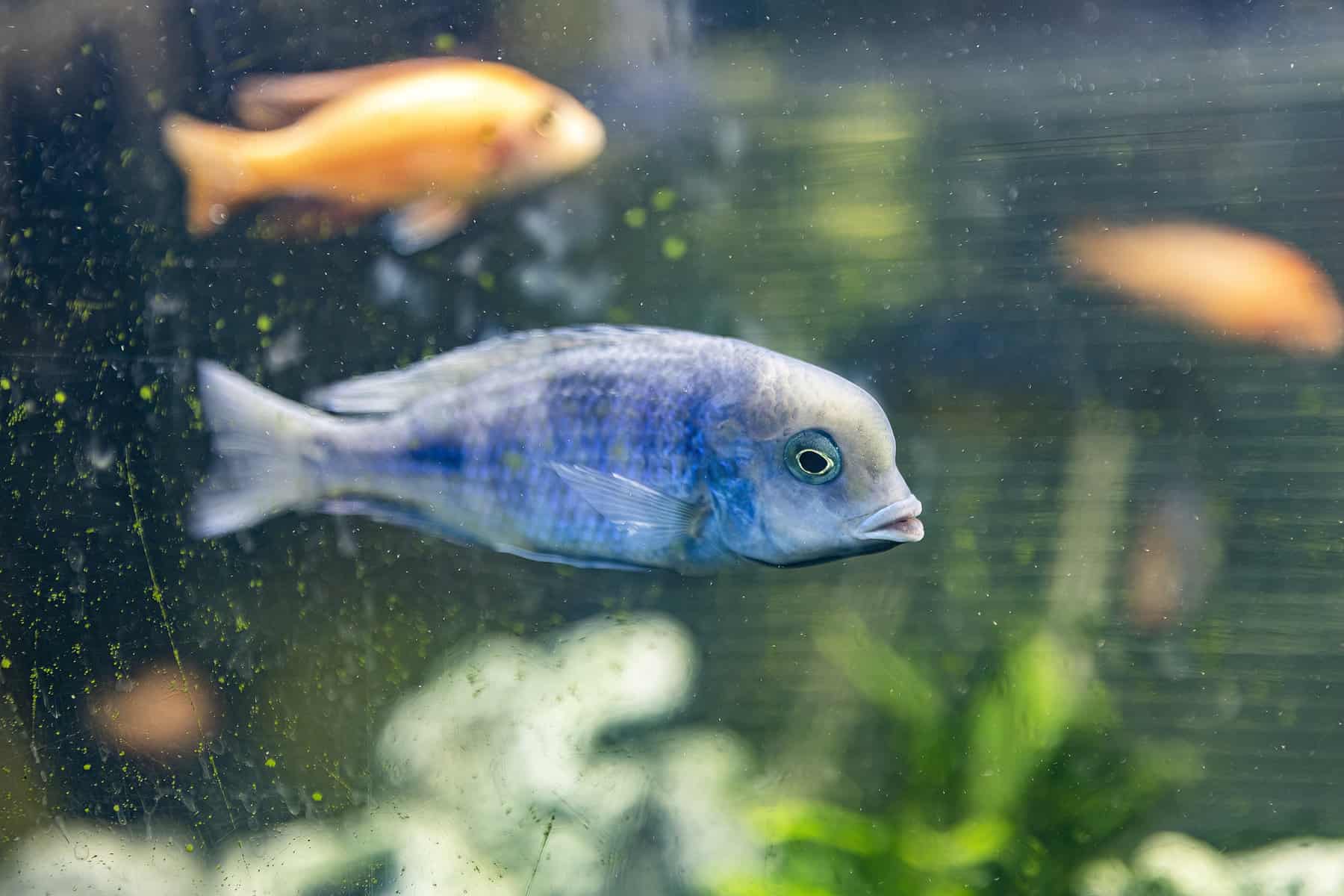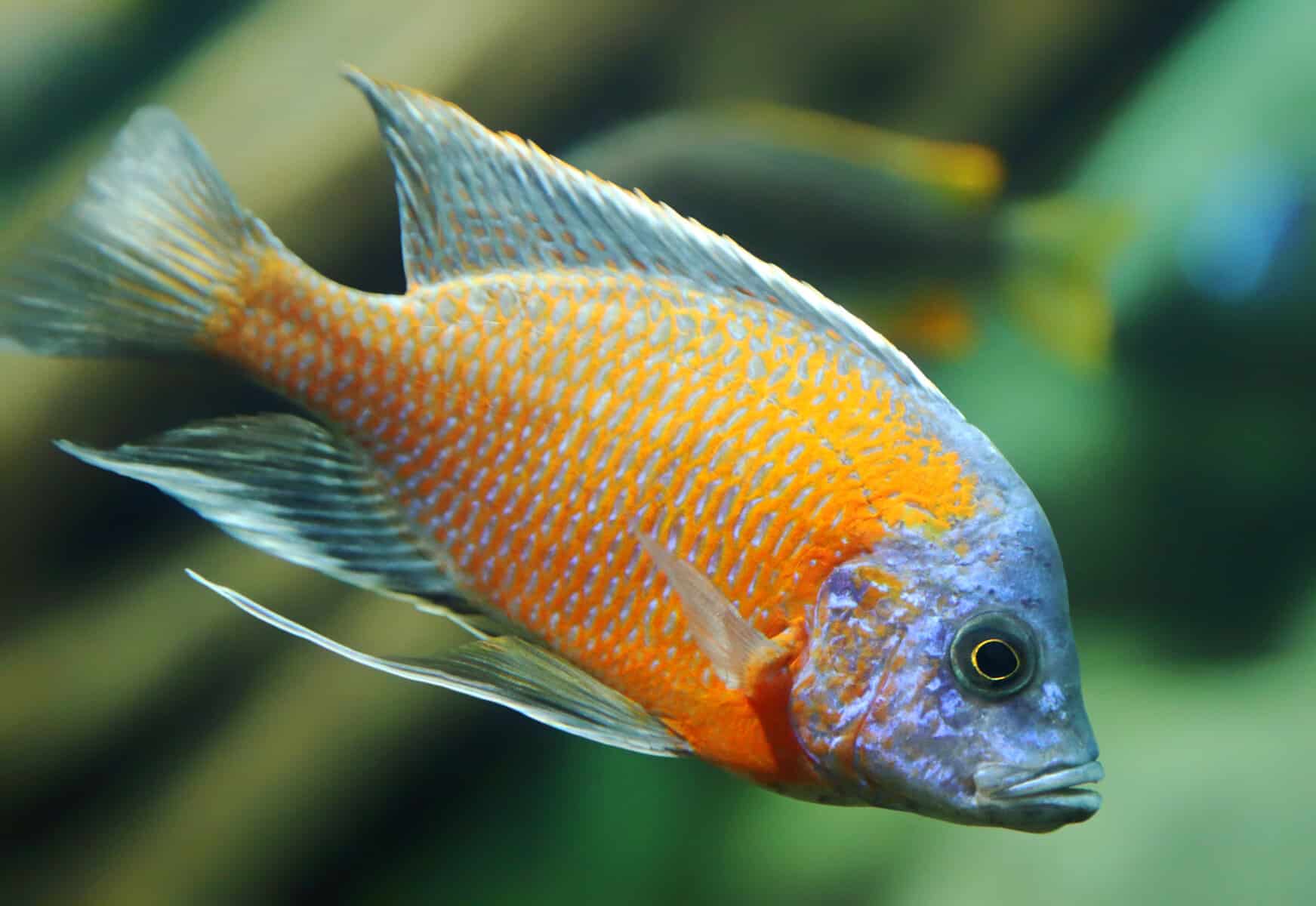[ad_1]
Hailing from Lake Malawi in East Africa, Electric yellow cichlids (aka. yellow labs) are understandably among the most popular of all African cichlids. Their radiant lemon-yellow color can evoke the atmosphere of a marine aquarium, especially when they’re kept alongside other fish with contrasting colors.
But which types of fish can you successfully keep them with? Electric yellow cichlids are mbunas – one of the most aggressive sub-families of cichlids in the world, so their tank mates need to be fairly tough to coexist with them peacefully!
On the other hand, they are also one of the smallest and more peaceful of the mbunas, meaning that large, aggressive mbunas might intimidate them. A careful balance of size and aggression needs to be sought for the ideal tank mates, and I’ve come up with 7 of the best choices here.
7 of the Best Electric Yellow Cichlid Tank Mates
Yellow-tailed Acei Cichlid
- Scientific Name: Pseudotropheus Acei
- Common Name: Acei Cichlid
- Size: 6 inches (15.2 cm)
- Diet: Omnivore
- Minimum Tank Size: 55 Gallons
Acei cichlids are among the very best tank mates for yellow lab cichlids. Also from Lake Malawi, the blue body combined with a yellow tail make this a stunning species of mbuna. Some variants have white tails instead of yellow and are known as ‘white-tailed aceis’.
Although they grow slightly larger, aceis are similar to yellow labs in their level of aggression, which is exactly what you’re looking for to create a harmonious setup!
Acei cichlids require similar care and diet to electric yellow cichlids, meaning they prefer mostly plant-based foods. Be advised that species can be especially prone to a digestive disorder known as ‘Malawi bloat’ if fed on too many meaty treats like bloodworms.
Electric Blue Hap
- Scientific Name: Sciaenochromis fryeri
- Common Names: Electric Blue Hap, Electric Blue Ahli
- Size: 8 inches (20 cm)
- Diet: Omnivore
- Minimum Tank Size: 125 Gallons
The gorgeous deep blue color of the male electric blue hap will contrast perfectly with the radiant yellow of the electric yellow cichlid. In fact, keeping the vibrant colors of these two species together can even resemble the intensity of a reef aquarium!
The electric blue cichlid exhibits strong sexual dimorphism – meaning that males and females look quite different. While the males are normally an intense metallic blue, the females vary in color and can even be brownish-gray.
Although hap cichlids are typically less aggressive than mbunas, some aquarists recommend not keeping more than one male electric blue hap in the same tank to avoid territorial fighting.
Peacock Cichlid

- Scientific Name: Aulonocara
- Common Name: Peacock Cichlid
- Size: 4-6 inches
- Diet: Omnivore
- Minimum Tank Size: 55 Gallons
Along with mbunas and haps, peacocks are the other most famous type of African cichlid. There are many different varieties, including some that have been hybridized with mbunas to create popular, brightly colored forms.
Naturally occurring peacocks include Freiberg’s Peacock, Flavescent Peacock, and Blue Orchid Aulonocara. Man-made hybrids include OB Peacock, Dragon Blood Peacock Cichlid, Flametail Peacock, and Strawberry Peacock Cichlid.
Since mbunas tend to be more aggressive than haps and peacocks, some aquarists have advised not keeping them together. But because yellow labs are one of the most peaceful mbunas they should be compatible as long as you give each fish plenty of swimming space and hiding places.
Demasoni Cichlid

- Scientific Name: Pseudotropheus demasoni
- Common Name: Demasoni Cichlid
- Size: 3 inches (7.5 cm)
- Diet: Omnivorous
- Minimum Tank Size: 55 Gallons
Becoming ever more popular with cichlid enthusiasts, the Demasoni cichlid has beautiful black and blue stripes and is said to be best kept in larger groups to manage their aggression.
These Lake Malawi cichlids only grow up to 3 inches long, making them one of the smaller mbunas. Some people even regard them as dwarf cichlids. This doesn’t make them any less aggressive though!
Like most mbunas, Demasoni cichlids are feisty fish who are not afraid to pick a fight with their neighbors. Luckily they’re about an inch smaller than electric yellow cichlids, so they can often make a good match. Just keep an eye on their behavior, though!
Blue Dolphin Hap

- Scientific Name: Cyrtocara moorii
- Common Names: Blue Dolphin Cichlid, Malawi Blue Dolphin Cichlid, Hump-head
- Size: 9.8 inches (24.99 cm)
- Diet: Carnivorous
- Minimum Tank Size: 125 Gallons
With their huge ‘nuchal hump’ on their forehead, it’s easy to see how these bright blue cichlids got their common name.
Blue dolphin haps are one of the gentle giants of the cichlid world. Even though they can grow to a whopping 10 inches long, they tend to be a surprisingly peaceful species and can be kept successfully with smaller cichlids like yellow labs.
Because of their large adult size and active swimming behavior, blue dolphin cichlids should only be kept in very large aquariums – it’d be cruel to keep them in a tank any less than 125 gallons.
Redfin Hap

- Scientific Name: Copadichromis borleyi
- Common Names: Redfin Hap, Red Fin Borleyi, Borleyi Hap, Borleyi Cichlid
- Size: 6 inches
- Diet: Omnivorous
- Minimum Tank Size: 75 Gallons
If you’re looking for a bright red cichlid to compliment the vibrant yellow of your yellow lab, the redfin hap (aka. Borleyi hap) could be a good choice.
A unique and stunning-looking fish, an adult redfin hap actually has a bright red body with more of a bluish head and fins. The name ‘redfin’ comes from the juveniles and females who have silver bodies but red fins.
Although they grow to a larger size than an electric yellow cichlid, these haps are renowned for being fairly peaceful tankmates and are unlikely to cause any trouble for other species of cichlids.
Taiwan Reef Cichlid
- Scientific Name: Protomelas sp. Steveni Taiwan
- Common Name: Taiwan Reef Cichlid, Steveni Taiwan, Chimoto Reds
- Size: 7 inches
- Diet: Omnivore
- Minimum Tank Size: 75 Gallons
With their electric blue head and upper body, combined with a yellow-red underside and tail, Taiwan reef cichlids are a real show-stopper. Although it looks more like a peacock cichlid, this species belongs to the hap family.
These are typically rather more peaceful fish than electric yellow cichlids, but since the Taiwan reef cichlid is substantially larger, the two species will generally get along fine.
Most African cichlids need to be clean to thrive, but the Taiwan reef cichlid is especially picky about water quality. Make sure you have a good filter and perform regular water changes to keep them happy.
Fish That Shouldn’t Be Kept With Electric Yellow Cichlids
Small or Delicate Fish Species
Although they’re one of the most peaceful mbunas, electric yellow cichlids are still relatively aggressive fish that must never be kept with small or fragile tank mates.
Small schooling fish like tetras will likely be killed and even eaten very quickly by these omnivorous fish, and even larger species like silver dollars and barbs are liable to get attacked.
Shell-dwelling African cichlids are also better kept with peaceful haps and peacock cichlids than mbunas like the yellow lab!
Fish Preferring Different Water Parameters
It must be remembered, too, that all mbunas are from Lake Malawi, which has hard, alkaline water, similar to that of the other Great Lakes of East Africa. All fish from these lakes need water parameters of around pH 7.5 – 8-5 and a hardness of approximately 12-25 gDH.
While people have sometimes suggested keeping South American cichlids like rainbow cichlids and Jack Demsey cichlids with African cichlids, these types of cichlids prefer soft, acidic water, and won’t be happy in the hard water setup of an African cichlid tank.
Fish That Need Plants
Because African cichlids (and especially mbunas) love to dig up and eat plants, it’s very difficult to keep any live plants with them! Their tanks are typically a stark layout of rocks, with synthetic plants as the only viable option.
Fish that love to inhabit planted tanks such as angelfish and keyhole cichlids won’t be happy with the bare, open tanks that African cichlids live in.
Find Out More About Electric Yellow Cichlids
To better understand what makes the perfect tank mates for yellow labs, it’s a good idea to get to know them inside out.
You can learn much more about the fascinating world of these colorful fish from our dedicated care guide here.
[ad_2]
Source link
